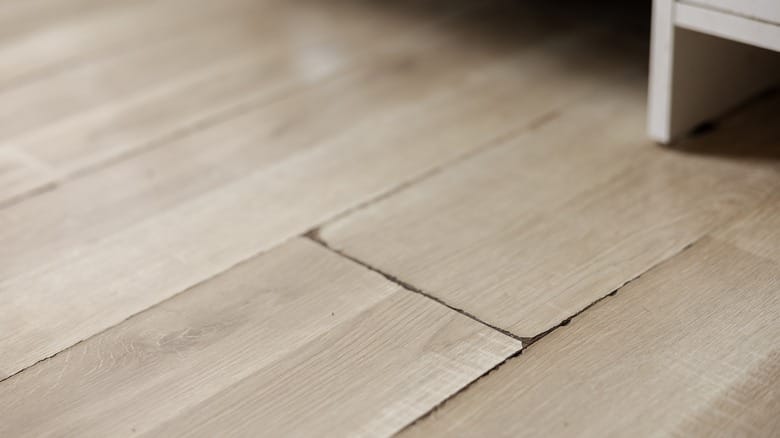Tucking your plumbing away behind walls and under floors means that you don’t need to deal with unsightly pipes. You can still get the water supply (and waste lines) you need but don’t have to look at them, keeping your home nice and tidy. You can even go one step further and encase some of your pipework in your basement slab—embedded in the concrete. While this means that the pipework takes up next to no real estate and will be protected most of the time, it does present one serious issue: access. Eventually, plumbing will face problems, and that’s when you might encounter a slab plumbing leak.
Understanding Slab Plumbing Leaks
Before we can get into the details of slab plumbing leaks, we’ll have to define slab plumbing and what exactly a slab is.
A slab is a concrete base that your house sits on. Depending on your particular building type, it probably makes up the floor of your basement. This solid layer of concrete provides a handy place to embed pipes that bring in fresh water and remove waste. Generally, being embedded in concrete keeps things stable, protected from knocks, and out of the way.
However, as every homeowner knows, things can and will go wrong. Slab plumbing leaks can present some pretty serious problems if they’re not dealt with quickly. But what causes them?
Causes of Slab Plumbing Leaks
Slab plumbing is protected from certain types of damage but is still susceptible to others. The most common problems are caused by:
- Corrosion: Different types of pipes are more or less susceptible to corrosion. Modern materials like PEX are very resistant, but older galvanized steel and similar materials will eventually rust through. Corrosion causes blockages and even holes as it eats away at the material of the pipe.
- Ground shifting: Soil isn’t static. It shifts and moves over time. This movement can put pressure on your pipes and slab, causing them to crack or even snap.
- Tree roots: Tree roots seek out water and, given enough time, can work their way through just about anything. If your slab plumbing is in their way, they’ll force their way in, breaking up your pipework.
- High water pressure: Every material has its limits, and if exposed to too much pressure for too long, it will burst. Even if the pipes themselves survive, joints and fittings can be damaged.
- Age of the plumbing: Nothing lasts forever, and plumbing is no exception. Over time, wear and tear will cause problems, including leaks.
Signs of a Slab Leak
Whenever water gets where it shouldn’t, it leaves some tell-tale signs that every homeowner should be on the lookout for. Some of these are obvious—if there’s a puddle, it must have come from somewhere. Some are more subtle.
Visual Signs
Visual signs can range from the subtle to the obvious:
- Wet spots on floors
- Damp carpets
- Mold and mildew growth
- Discolored or warped flooring
Audio Cues
Even without obvious visual signs, your sense of hearing can give you vital clues about a slab plumbing leak. In fact, audio detection using specialized equipment is often used to pinpoint problems that can’t be easily inspected visually.
These generally present as constant dripping or running water sounds that you can’t locate or gurgling/hissing sounds coming from the floor.
Other Signs
Other signs that water is causing issues include:
- Unexpected rises in your water bill
- Sudden loss of water pressure
- Hot spots on the floor (suggesting your leak is on the hot water line)
- Musty smells in the basement
Detecting Slab Leaks
Detecting and locating the position of a slab plumbing leak could involve a few different techniques:
- Visual inspections: Carefully inspecting floors, walls, and ceilings should give clues about where the problem lies. You’re looking for signs of moisture or damage caused by water.
- Acoustic detection: Specialized equipment, consisting of a microphone and headset, can pinpoint the exact location by amplifying the sounds the leak makes.
- Infrared thermography: Using specialized cameras, you can detect differences in temperature around the site of the leak. Generally, the water will be either hotter or colder than the surrounding concrete.
- Dye testing: Adding dye to the system means that you can trace the staining back to the source. This is particularly useful in waste pipes.
Repairing a Slab Leak
While access is a potential problem with embedded pipework, you’re not without options for fixing the problem. Some solutions are non-invasive, but others will require excavation.
- Pipe lining: A non-invasive solution to a slab plumbing leak. This involves inserting a liner into the pipe. These are soft, flexible resin tubes that are pushed through the pipe until they reach the problem area. Once in place, the tube is inflated, pushing hard against the walls of the pipe. It’s then allowed to cure. The final result is a watertight pipe-within-a-pipe that allows you to use the system as normal.
- Excavation: If access is tricky or the problem has become more serious, excavation might be needed. This involves cutting the slab to create a trench around the problem area to allow easy access and replacing the damaged section.
In extreme cases, the only viable option might be to dig up the slab and repipe the whole area. This is worth considering if extensive damage has been caused by an undetected leak or multiple problems have arisen simultaneously.
Preventing Slab Leaks
While repairs are possible, it’s always better to avoid the issue in the first place. Cutting down your home’s risk of experiencing a basement slab leak isn’t foolproof, but these basic tasks can help:
Regular Plumbing Maintenance
Scheduling a general check-up on your home’s plumbing once a year can alert you to emerging issues before they become serious. These inspections should cover all your pipework (including slab plumbing), fixtures, and fittings.
Maintain Water Pressure
While a powerful shower is appealing, excessive water pressure puts strain on your pipes and will drastically shorten their lifespan. Steps to address this include:
- Partially closing your main stop valve to reduce the flow.
- Installing a Pressure Regulator Valve (PRV) to control water pressure more accurately.
Address Tree Root Issues
Carefully consider what you’re planting and where. Tree roots can easily spread as far as the tree is tall and sometimes farther. They can damage pipework, walls, or floors. Installing root barriers or consulting with a tree professional can help mitigate this risk.
Install a Water Leak Detection System
A water leak detection system can alert you to problems before they worsen. Some systems can even shut off the water supply automatically, saving time, money, and disruption.
While slab leaks pose challenges, they’re manageable with the right team of professionals. Avoid unsightly pipework and keep your basement dry and safe with proper maintenance and early detection.

